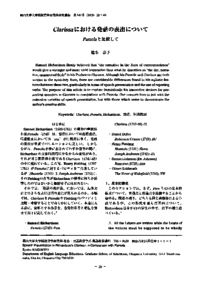

Bulletin of Graduate School of Education, Okayama University
Published by Graduate School of Education, Okayama UniversitySpeech Presentation in Richardson's Clarissa: In Comparison with Pamela
Published Date
2009-10-21
Abstract
Samuel Richardson firmly believed that "the narrative in the form of correspondence" would give a stronger and more vivid impression than what he describes as "the dry, narrative, unanimated Style" in his Preface to Clarissa. Although his Pamela and Clarissa are both written in the epistolary form, there are considerable differences found in his stylistic features between these two, particularly in terms of speech presentation and the use of reporting
verbs. The purpose of this article is to explore linguistically his innovative devices for presenting speeches in Clarissa in comparison with Pamela. Our concern here is not with the extensive varieties of speech presentation, but with those which serve to demonstrate the
author's creative skills.
Keywords
Clarissa
Pamela
Richardson
話法
伝達動詞
ISSN
1883-2423
NCID
AA12338258
NAID
JaLCDOI
